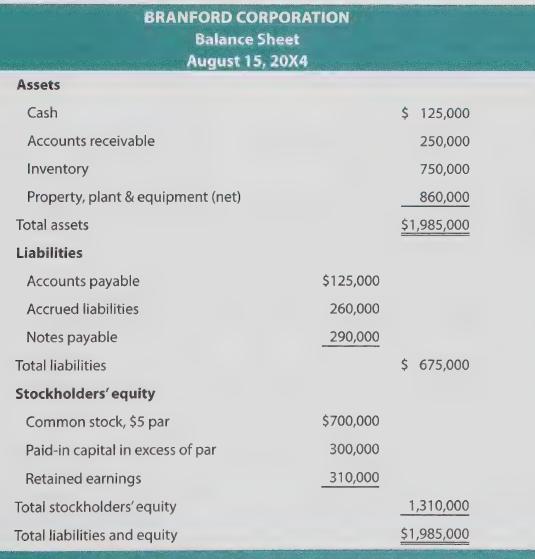Summary information for Branford Corporation's balance sheet follows: Branford's business is growing rapidly, and the company needs
Question:
Summary information for Branford Corporation's balance sheet follows:

Branford's business is growing rapidly, and the company needs to expand its manufacturing facilities. This expansion will require the company to obtain an additional \($1\),000,000 in cash. The company is exploring five alternatives to obtain the necessary capital:
DEBT OPTION:
Branford is able to borrow, on a 5-year note, the full amount needed. The interest rate on this note would be 7%, and the note would require monthly payments.
COMMON STOCK OPTION:
Branford has identified an investor who is willing to pay \($1\),000,000 for 40,000 newly issued common shares. Common shares have been paying a dividend of \($0.50\) per share.
Branford anticipates that this dividend rate will be maintained.
NONCUMULATIVE PREFERRED STOCK OPTION:
Branford has identified a hedge fund that will pay \($1\),000,000 for 8% noncumulative preferred stock to be issued at par.
CUMULATIVE PREFERRED STOCK OPTION:
Branford has identified an insurance company that will pay’\($1\),000,000 for 6% cumulative preferred stock to be issued at par.
CONVERTIBLE PREFERRED STOCK OPTION:
Branford has identified a retirement fund that will pay \($1\),000,000 for 4% cumulative preferred stock to be issued at par. The preferred stock must be convertible into 25,000 shares of common stock at the option of the retirement fund.
(a) Prepare the revised balance sheets that would result under each of the five alternative financing scenarios.
(b) Which of the alternative financing scenarios involve fixed committed payments to investors, and which involve discretionary payments?
(c) Which one of the alternative financing scenarios presents the least risk to existing shareholders?
Which one of the scenarios involves the most ownership dilution for existing shareholders?
(d) Which scenario is most risky, and does it require any ownership dilution for existing shareholders?
(e) What is the price per share that is implicit in the common stock alternative? What price per share must the common stock reach before convertible preferred shares might logically be converted?
Why might the preferred share alternatives involve different yields?
(f) Evaluate the balance sheets prepared in part (a). Which appear similar? Given that certain balance sheets appear similar, yet the fundamental economic positions vary, what is to be learned about carefully examining financial statements and notes?
Step by Step Answer:






